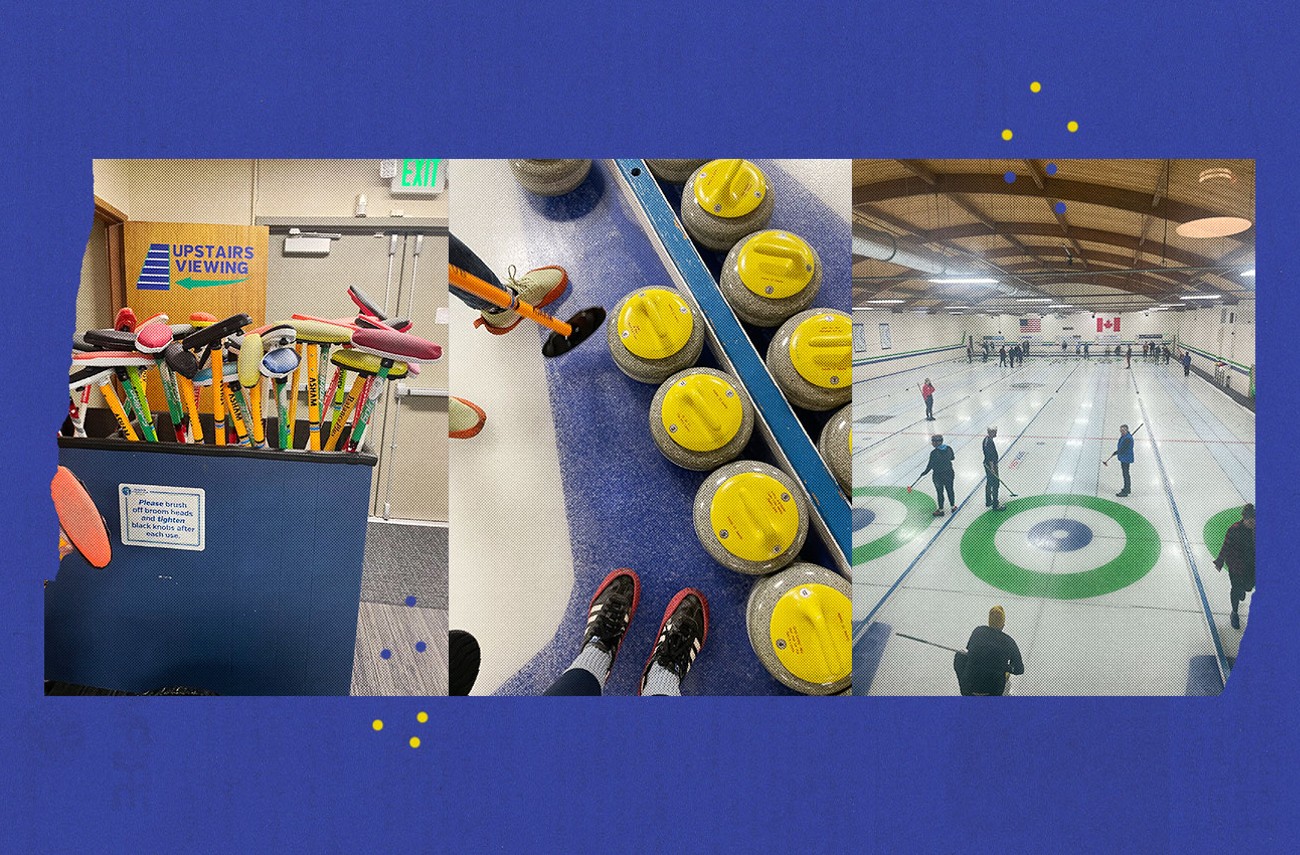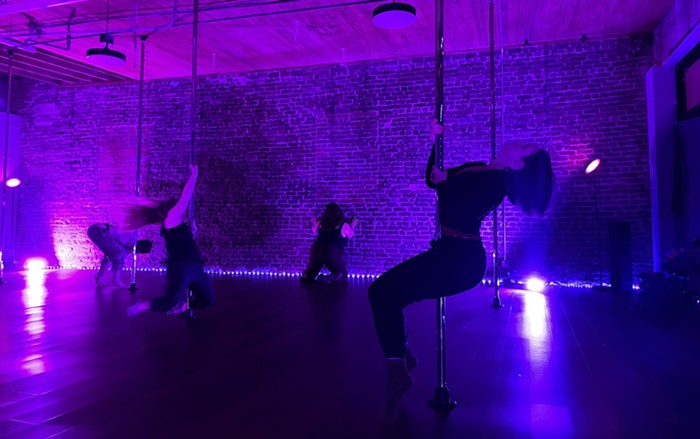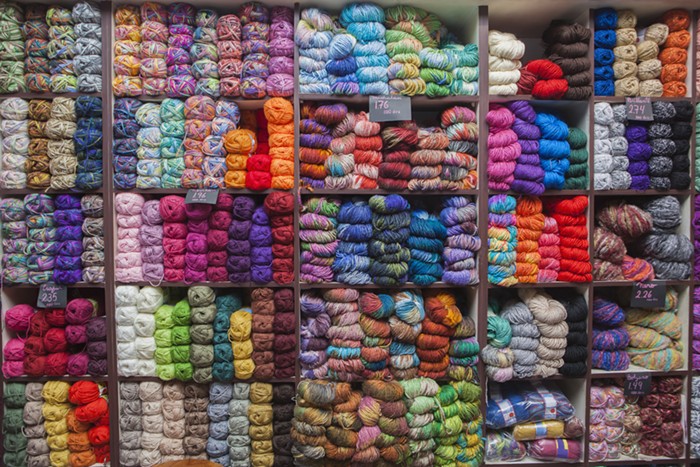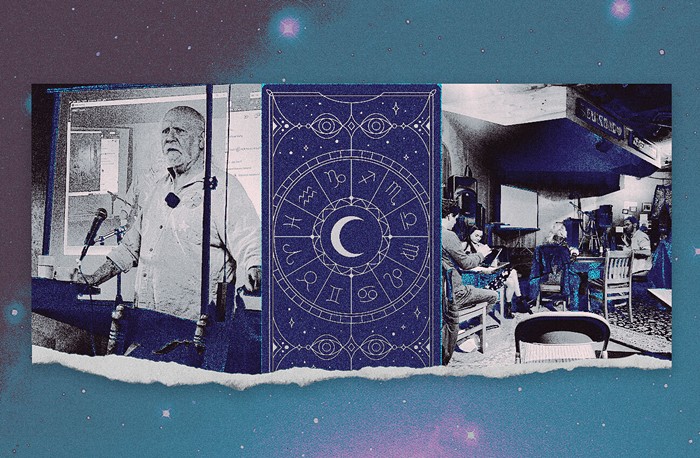When I stepped onto the ice, I could taste the cold; a chemical, ozone smell mixed with the crisp cool of the indoor ice sheets and the mustiness of the 62-year-old building that housed them. I inhaled deeply, the air stinging and sharp.
Despite curlers playing on either side of me, the scene was quieter than I expected, as if the cold had frozen the sound waves.
Barriers divided the ice into five separate 180-foot playing surfaces, or "sheets." In the second-floor warm room above the sheets, a slew of novice league curlers watched the competition through long, rectangular windows. Up there, pitchers of beer and pint glasses littered tables painted to resemble the "house," the name for the bullseye-looking target where curlers aim stones to score.
My shoes slipped despite the orange gummy grippers I wore around them.
“Give those a second to cool down and they’ll grip more,” Neal Digre, 29, told me. Curling piqued his curiosity many Winter Olympics ago, and he finally took the leap after the 2018 games, when the US men’s team won gold. He found this place and fell in love with the people and the sport.
The people are the Granite Curling Club, a Seattle staple since a group of Ballard doctors founded it in 1951. The place, a faded light blue building, sits squat and lonesome on a North Seattle lot near Aurora Avenue. It is one of only three curling-specific facilities, or, as curlers call it, “dedicated ices,” on the West Coast.
With a growing membership, celebrity curlers (Luc Violette curls there! Colin Hufman, too!), you might think GCC is for cold, hard competition only. Nah. The place’s bread and butter is its community members.
The club hosts themed tournaments and parties regularly. Some curling nights each week are supper clubs and potlucks. Every match ends with the winners buying the losers a pitcher of beer. Anyone can come in and watch, whether or not they’re playing. For many, GCC is their third place—the place outside of work and home, where they spend their time and find community.
For my latest exploration into Seattle’s subcultures, I stumbled on the ice and onto a group of people eager to put a beer in my hand and give me a seat at their table.
Chess on Ice
Curling is a sport people gawk at in the Olympics because it looks easy. Two teams—either doubles or teams of four—face off by sliding stones across ice. (They source the specially-made stones from a Scottish isle.) Sweepers use brooms with heads made from the same material as patio umbrellas to melt the ice and coerce the stone’s path. The goal is to get the stone as close to the center—or the "button"—of the house as possible.
Mostly, curling looks doable. That’s what got Will Dimmitt, 40, into the sport.
“It looks approachable,” Dimmitt said. “It’s not 22-year-olds in peak athletic condition operating in the 95th and above percentile of human capability.”
The average age of competitive curlers in the US hovers around 34. That’s because, while the sport takes athletic ability, it’s more than that.
Berit Tomten, 39, a former Division 1 rower at the University of Minnesota, said curling "humbled" her.
"I shouldn't say this," she said, "But, it’s the only sport I’ve played where I have to think a lot."
There's a lot of thinking in curling.
“It’s situational awareness, it’s balance, and strength, and strategy, and control,” Dimmit said. “I love the strategy. The cliche that gets knocked around is its chess on ice. You’re trying to stay a move or two ahead of your opponent.”
He and his wife, Kate Fox, 41, started curling five years ago when they were still new to Seattle. They’re at GCC anywhere from two to four nights a week.
“Curling is both approachable and absolutely maddening,” Fox said. “There’s never something you don’t need to work on. There’s always something to do.”
Mastering the sport is all about tweaking your form, studying the changes to the ice, learning to release the rock at the right moment, and knowing how to judge force and weight. It’s complicated, and it takes hours and hours of practice, but it doesn’t have to be that serious.
Friday nights are basically a party each week, Fox said.
“You go, throw a few rocks, have the community, then have a few drinks afterward and not take it as seriously,” she said.
Sometimes, she just goes to GCC to hang out even if she’s not curling.
“I don’t want to sit at home, so I'm going to sit at the curling club and chat with people,” Fox said.
Drinking on Sheet 6
When I first arrived at GCC, I was looking for Bryan Pittard, 46. Pittard, who works in the Navy, is GCC’s director of outreach. He’s also the bartender.
Feeling a little apprehensive, I picked my way up the creaking staircase to the warming room. A few people chatted near the windows, watching the games below. Through a hallway off to the side, I found the bar, a room with big windows for game spectating. Pictures of curling history dotted the walls. The club has jokingly started calling the bar "Sheet 6" since it overlooks the five curling playing surfaces.
Pittard stacked glasses, festive ornaments hanging from his gray beard. (“My beardaments,” he called them.) Jingle bells jingled on his wrist.
“I have a sordid history with curling,” Pittard said. “I’m from Florida. We don’t have a lot of curling in Florida. Not a lot of ice.”
As with most people, the Winter Olympics sparked his interest in the sport. He couldn’t find anywhere to curl in Orlando, so another Olympics came and went—until he found a curling Yahoo! group.
“I messaged them and I said, ‘I want to come curl.’ They said, ‘Oh, we don’t curl. This is an interest group. We have no ice. We have no things,’” Pittard recounted.
Instead of giving up, he asked what he could do to help. The group pointed him to an ice rink he could rent. Without knowing the first thing about curling, he started an Orlando curling club.
“Curling has shaped my life very strongly over the last decade,” Pittard said.
Years later, the Navy offered him a chance to move out of Florida. As a queer man, he was ready to move to more progressive pastures. Choosing between Seattle or San Diego, he settled on Seattle because its curling club had a dedicated curling facility.
Throughout his life, Pittard has sought out communities.
“I find these communities, these tribes, and find overlapping communities and that sense of belonging,” he said. “The curling club is a lot of that for us. Church, third place, family, friend group, sports, all of it together.”
As we talked, curlers fresh from the ice came in for a drink. Winner buys. That’s the custom.
Richard Palmason, 55, was one of them.
His grandfather was the first chief of staff at Ballard Hospital, and he curled at GCC in his spare time. “I remember coming here a lot as a kid,” he said.
He didn’t start curling himself until 2015. It’s where he met his girlfriend when she subbed in on his team one night years ago, then kept dating him despite a “nightmare first date,” Palmason said. They curl together, but only about 10 games a year since they’re both so competitive. He also employs several curlers in his construction business.
I stood on Sheet 2 for my first attempt at curling. It was the same sheet where Palmason and his girlfriend met. It was the same sheet where Palmason’s girlfriend’s Basset hound, Harvey, dropped a deuce during an “ice out party,” Palmason said.
“[During those events] the rocks are off. The guards are off. You can run your dogs around. People ice skate and dribble hockey pucks,” he said. “Harvey took a dump on the back of the house on Sheet 2. Someone took a video. There were a whole bunch of people who saw it, screaming ‘he hit the house.’”
Harvey, now dead, is immortalized on the back of Sheet 2 in a picture set in one of the circles where the rocks stay before they’re thrown.
Curling on Sheet 2
Digre crouched down, put one foot on blocks that resemble the ones used in track, and dropped his knee-padded knee onto the ice. He held the rock in his dominant hand, gripped a push-up-bar-looking support in his other hand, and placed his left foot on a slick plastic “slider.” He kicked off with his right foot, sailing into a slow-motion lunge, and then released the rock.
When I mimicked this motion, I fell over. In fact, I fell over a couple of times. I released the stone too late. I pushed it too hard. But, eventually, with Digre’s instructions, my rock sailed into the house. Then another one sailed into the house. And then a third. He jumped up and down for me. “That was so good,” he said, making me glow with his feedback. I shouldn’t have been surprised, he runs a curling podcast called “Sweeping Affirmations,” after all.
(Curlers say the first time curling is easier than all the other times. Once you start trying for consistency, the sport becomes harder.)
Sweeping was way harder than I thought. In order to actually make a difference, you have to lean your whole body weight on the broom head and sweep. It’s like doing a lopsided, standing plank. I was not good at this part.
As we wrapped up our tutorial, Digre made sure to tell me the most important rules.
“Always start a match by saying ‘good curling’ and shaking hands,” he said. The game always ends with a handshake and nice words, too.
When I headed upstairs with damp leggings in the places where I fell on my ass, we all shared a pitcher of beer. Sitting around the table, the curlers gossiped about someone who not only took more than their allotted time on the ice but also did not shake hands after playing. This is sacrilege in curling. Etiquette is king, especially because all fouls in curling are self-reported; there are no refs.
Broom-slamming also came up. Apparently, people are unhappy with the passionate few curlers who slam their brooms on the ice when they’re happy or upset.
“It’s become a whole thing,” Pittard said. “It’s being elevated to the board’s attention.”
Give Me the Spiel
Nick Connolly, 27, who is headed to the national championships for the third time come January, has been curling at GCC since he was eight. His older brother started curling. Connolly, ever following in his big brother’s footsteps, tried it out.
Aside from his own prowess, the community is the thing that’s kept him around.
“It’s the most loving group of people you’ll ever find,” he said.
GCC hosts multiple tournaments each year called bonspiels, or just spiels. The best one is the April spiel, a 72-hour themed event. Last year, the theme was "under the sea." Curling starts on Thursday and ends at midnight. Then, come Friday, it’s straight curling for 22-hours a day each day through Sunday. Games happen at all times except 5 am, but there are games at 3 am and at 7 am. Depending on how your team does, you may have to play in the middle of the night.
This year, Connolly did too well, so he only played at normal times.
“It’s like a whole party,” Connolly said. “There’s costumes, karaoke, food, and curling.”
People sleep in their trailers in the parking lot or on the couches at GCC. Cooks and caterers who are curlers volunteer their time and skills to cook heaps of food. One spiel, Fox said, she spent eight hours helping fry chicken next to the dumpsters at GCC.
“This is one of the biggest parts of my life,” Connolly said. He reflected on those years as a kid when he and his friends would stay up until the forbidden times of the night to curl during April spiel. “Growing up in this curling club—in this place—was so special.”
After nationals, he’s not sure what’s next. What he’s certain of is he’ll be around GCC no matter what.
“I’ll be here until the day I die for sure,” Connolly said. “Even if I stop curling competitively, I'll be here.”




















